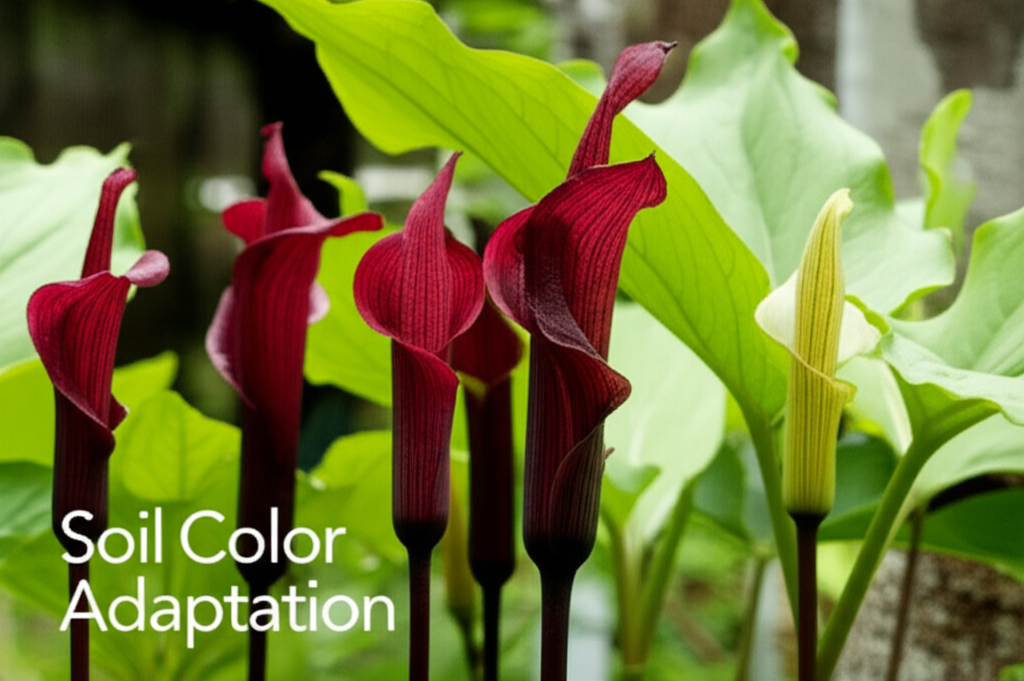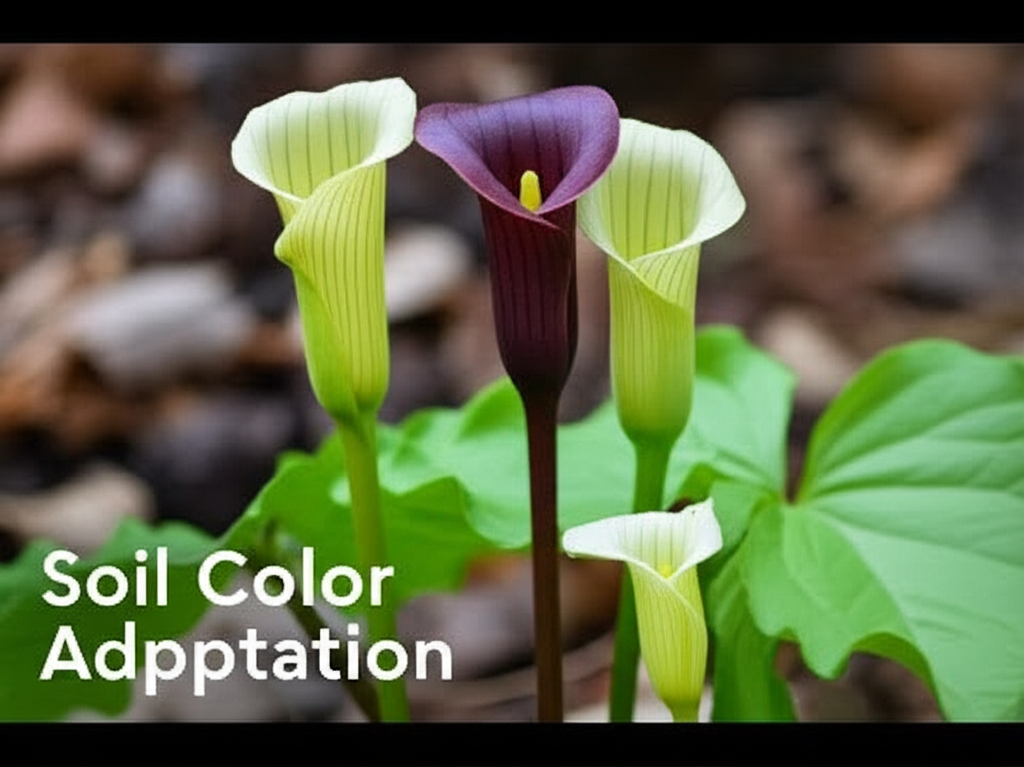Unveiling the Jack-in-the-Pulpit: More Than Just a Pretty Face
The Jack-in-the-Pulpit (Arisaema triphyllum) is a captivating woodland wildflower, instantly recognizable by its unique hooded spathe and the erect spadix – the “jack” within the “pulpit.” While its distinctive structure often garners the most attention, a subtler, yet equally fascinating, aspect of this plant’s biology lies in its flower color adaptation to varying soil conditions. This article delves into the intricate relationship between soil chemistry and the vibrant hues, or sometimes subtle variations, observed in the Jack-in-the-Pulpit’s reproductive structures, exploring the ecological and evolutionary drivers behind this chromatic dance.
A Symphony of Soil: Understanding the Foundation
Before we examine how the Jack-in-the-Pulpit’s colors shift, it’s crucial to understand the foundational role of soil. Soil is far from a uniform medium; it is a dynamic ecosystem teeming with minerals, organic matter, and microbial life, all influencing the pH, nutrient availability, and moisture retention. These factors, in turn, directly impact plant physiology, from root development to pigment production.
Soil pH: The Master Regulator
Soil pH, a measure of its acidity or alkalinity, is a primary determinant of nutrient availability. Most plants, including the Jack-in-the-Pulpit, thrive within a specific pH range. Deviations from this ideal can make certain essential nutrients either unavailable for absorption or toxic in excess.
Nutrient Dynamics: The Building Blocks of Color
Key nutrients such as nitrogen, phosphorus, potassium, magnesium, and iron play vital roles in plant growth and development. Nitrogen, for instance, is a component of chlorophyll, the green pigment essential for photosynthesis. Other minerals can influence the synthesis and stability of anthocyanins and other pigments responsible for the reds, purples, and browns often seen in the Jack-in-the-Pulpit’s spathe.
Organic Matter and Microbial Influence
The decomposition of organic matter releases nutrients and influences soil structure. Furthermore, the vast community of soil microbes interacts with plant roots, facilitating nutrient uptake and even producing compounds that can affect plant color.
The Jack-in-the-Pulpit’s Palette: Observing the Color Variations

The Jack-in-the-Pulpit, typically found in moist, shaded woodlands, exhibits a range of colors that are not merely aesthetic but are likely adaptive responses to its environment. While the “standard” Jack-in-the-Pulpit is often described as having greenish or purplish spathes, close observation reveals a broader spectrum.
The Spectrum of the Spathe and Spadix
The most visually striking part of the Jack-in-the-Pulpit’s reproductive structure is the spathe, a modified leaf that enfolds the spadix. The spadix itself, bearing the true flowers, can also display subtle color variations.
- Greens and Yellow-Greens: These are common, particularly in plants growing in deeply shaded areas where high chlorophyll content is beneficial for capturing limited light.
- Purples and Reds: Deeper shades of purple and reddish-brown often appear when plants are exposed to more direct sunlight or when certain pigments are more readily synthesized. These colors can be linked to anthocyanin production, which can act as a photoprotective mechanism.
- Striped and Mottled Patterns: Many Jack-in-the-Pulpits display intricate striping or mottling, with combinations of green, purple, and brown. The density and pattern of these markings can be highly variable.
Beyond the Spathe: Other Reproductive Structures
While the spathe is the most prominent, the spadix can also exhibit color, often a darker green or purplish hue. The berries, which develop after successful pollination, are typically bright red, serving as a visual attractant for seed dispersers.
The Soil-Color Connection: Unraveling the Mechanisms
The observed color variations in Jack-in-the-Pulpit are not random. Scientific understanding points to several key ways soil conditions influence pigment production.
Anthocyanins: The Pigments of Protection and Attraction
Anthocyanins are water-soluble pigments that can range in color from red to purple to blue. In plants, they play multiple roles:
- Photoprotection: In areas with higher light intensity (often correlating with more open or disturbed soil patches), anthocyanins can absorb excess light energy, preventing damage to photosynthetic tissues.
- Temperature Regulation: Darker colors can absorb more solar radiation, potentially warming the reproductive structures and aiding in pollen development or insect attraction.
- Attraction of Pollinators and Seed Dispersers: While less studied in Jack-in-the-Pulpit specifically, anthocyanins in other species are known to signal ripeness or nutritional value to pollinators and dispersers.
Influence of Soil pH on Pigment Synthesis
Soil pH directly impacts the availability of ions essential for pigment synthesis. For instance, the availability of certain metallic ions can influence the stability and expression of anthocyanins, leading to deeper or more vibrant colors in specific pH ranges. While direct studies on Jack-in-the-Pulpit are limited, research on other plants suggests that slightly acidic to neutral soils might favor certain anthocyanin expressions.
Nutrient Availability and Pigment Precursors
The synthesis of any pigment requires specific precursor molecules, which are derived from nutrients absorbed from the soil. Deficiencies or excesses of certain nutrients can limit the production of these precursors, thus affecting pigment intensity.
- Nitrogen: Essential for general plant growth and chlorophyll production. Balanced nitrogen levels are crucial for overall plant health, which indirectly supports pigment synthesis.
- Magnesium: A central component of chlorophyll. While not directly involved in anthocyanins, healthy chlorophyll levels indicate a healthy plant capable of producing other pigments.
- Trace Elements: Minerals like iron and manganese can act as cofactors in enzymatic reactions involved in pigment biosynthesis.
Key Facts and Soil Comparison
To illustrate the potential impact of soil on Jack-in-the-Pulpit, consider the following comparison. While direct, quantified studies on Arisaema triphyllum color change based on soil are scarce in readily accessible literature, the principles are well-established in plant science.
| Soil Condition | Typical Jack-in-the-Pulpit Appearance (Hypothesized) | Underlying Soil Characteristics | Potential Ecological Rationale |
|---|---|---|---|
| Rich, Moist, Slightly Acidic (pH 5.5-6.5) | Vibrant green spathes with potential deep purple veining. Healthy, robust growth. | High organic matter, good drainage, ample available nutrients (N, P, K, Mg). | Optimal conditions for photosynthesis and growth. Purple pigments may offer some UV protection in dappled sunlight. |
| Drier, More Compact, Slightly Alkaline (pH 6.8-7.5) | Paler green or yellowish-green spathes, potentially less pronounced purple markings. Stunted growth. | Lower organic matter, poorer drainage, potential nutrient lockout (e.g., phosphorus, iron) due to higher pH. | Plant under stress, prioritizing survival over robust pigment development. Reduced energy for complex pigment synthesis. |
| Disturbed, Exposed, Potentially Nutrient-Poor | Deeper purples, reddish-browns, or more intense striping on the spathe. | Higher light exposure, potential drought stress, variable nutrient levels. | Anthocyanins acting as photoprotective agents against strong sunlight. Possibly signaling stress or resource limitation. |
Investigating the Adaptation: Research and Observation
Understanding the precise mechanisms requires detailed scientific investigation. While anecdotal evidence and general botanical knowledge suggest a strong link, formal research often involves:
Controlled Environment Studies
Researchers can grow Jack-in-the-Pulpits in controlled environments with manipulated soil conditions (pH, nutrient levels) and observe the resulting color changes. This allows for isolating variables and establishing direct causal relationships.
Field Surveys and Correlation Analysis
Long-term field studies involve mapping Jack-in-the-Pulpit populations across diverse soil types. By recording soil characteristics and spathe colors of numerous individuals, researchers can identify correlations and hypothesize about adaptive significance.
Pigment Analysis
Sophisticated laboratory techniques, such as High-Performance Liquid Chromatography (HPLC), can be used to identify and quantify the specific pigments present in spathes from different soil types. This provides molecular evidence for the observed color variations.
Steps to Observing and Understanding Soil-Color Adaptations
For the amateur botanist or curious gardener, observing these adaptations can be a rewarding experience.
- Choose Your Study Area: Identify a woodland or natural area where Jack-in-the-Pulpits grow. Look for areas with noticeable variations in soil type, moisture, and light exposure.
- Observe Soil Characteristics: Note the soil’s texture (sandy, loamy, clayey), moisture level (wet, moist, dry), and any visible signs of organic matter. If possible, use a pH testing kit to get an approximation of acidity or alkalinity.
- Document Jack-in-the-Pulpit Appearance: Carefully observe and photograph the spathe color, noting any patterns, striping, or overall hue. Pay attention to the size and vigor of the plant.
- Compare Observations: Look for patterns. Do plants in darker, richer soils tend to have certain colors? Do those in more exposed or drier areas exhibit different hues?
- Research Local Flora: Consult local field guides or botanical resources to understand the typical soil preferences of Jack-in-the-Pulpit in your region.
Pros and Cons of Color Adaptation
The ability of the Jack-in-the-Pulpit to adapt its coloration to soil conditions presents both advantages and potential challenges.
| Aspect | Pros | Cons |
|---|---|---|
| Photoprotection | Deeper colors (e.g., purples, reds) can absorb excess UV radiation and light, preventing cellular damage in sun-exposed environments. This allows the plant to colonize a wider range of microhabitats. | Over-production of pigments can be energetically costly for the plant, especially in nutrient-poor soils. |
| Pollinator/Disperser Attraction | While not definitively proven for Jack-in-the-Pulpit, vibrant colors in other species can signal fitness or availability to pollinators or seed dispersers. | Specific colorations might attract the wrong pollinators or attract predators. |
| Resource Allocation | The plant can prioritize pigment production over other growth processes when conditions are favorable, or vice versa, when resources are scarce. | If pigment production interferes with essential processes like photosynthesis or reproduction under adverse conditions, it can reduce survival or reproductive success. |
| Environmental Signaling | Color can serve as an indicator of soil conditions, potentially influencing interactions with other organisms in the ecosystem. | The signaling may not always be perfectly interpreted by other species, leading to miscommunication or sub-optimal interactions. |
| Adaptability | The flexibility in color allows the species to thrive across a broader spectrum of woodland microclimates and soil compositions. | Extreme soil conditions may still exceed the plant’s adaptive capacity, leading to localized declines or absence. |
Conclusion: A Testament to Nature’s Ingenuity
The Jack-in-the-Pulpit, with its enigmatic form, reveals yet another layer of complexity when we consider its flower color adaptation to varying soil conditions. The subtle shifts in the spathe’s hues are not mere aesthetic choices but are deeply rooted in the plant’s physiological responses to soil pH, nutrient availability, and light exposure. This remarkable adaptation allows the Jack-in-the-Pulpit to not only survive but to thrive in diverse woodland environments. By understanding the intricate interplay between soil chemistry and pigment production, we gain a deeper appreciation for the resilience and evolutionary ingenuity of this beloved native wildflower. The next time you encounter a Jack-in-the-Pulpit, take a closer look – its colors may be telling a fascinating story about the ground beneath its roots.


